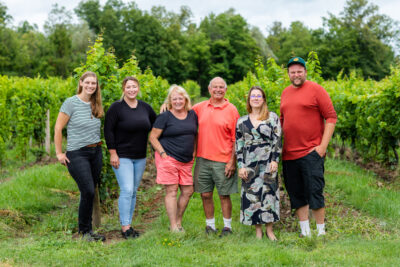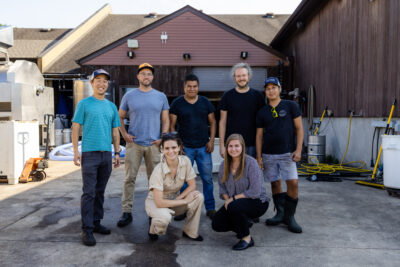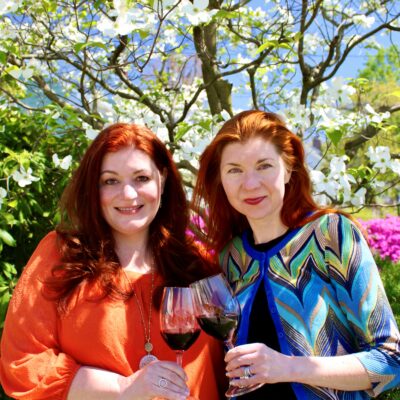Vineyards today are a far cry from their manicured, perfectly-trimmed-and-green predecessors of yore. In the 1960s, you were likely to glimpse neat rows of vines with pristine rows of soil between them—not a weed or cover crop to be seen. Chemicals seemed to be the answer to better wine growing. Herbicides destroyed the weeds that competed with the vines for water. Insecticides got rid of critters that wanted to use the vines and the grapes as food. Fungicides stopped mold and rot.
For a short time, all seemed fine until grape growers, and many other farmers, realized that these conventional chemicals created other problems in the vineyard. Biodiversity plummeted. Insecticides got rid of harmful bugs, but also wiped out beneficial ones. Some fungicides not only killed fungus, they killed beneficial organisms, including yeast.
And so, another shift happened, a shift often referred to as sustainable viticulture. For decades now, many New York grape growers have been moving away from conventional chemical use when possible and moving toward mechanical practices and biologicals as part of holistic vineyard management.
The Problem with Sustainability
Ask most grape growers if they want to be sustainable, and they’re most likely to say, “Of course.” But ask them to define what that means, and the answer will be less definitive. And therein lies the problem with sustainability, or at least the broad use of the term sustainability. There is no technical definition of the term when it comes to vineyards, and it can mean different things to different wine growers.

“I don’t believe sustainability—true sustainability—currently exists,” says Timothy Hosmer, Grower at Hosmer Winery on Cayuga Lake. “Farming is innately in conflict with the earth’s natural (sustainable) state. Nature wants our agricultural fields to be forests, and that would be its truly sustainable state. Therefore, sustainability comes only in shades of gray. There is no ‘sustainable’ only ‘more’ or ‘less’ sustainable.”
So perhaps it’s more accurate to say that the shift that’s happened over the past decades has not been to sustainable viticulture, but to, as Hosmer put it, “more” sustainable viticulture.
What does “more” sustainable look like? For Macari Vineyards on Long Island’s North Fork, where soil health has been a focus since the vines were planted in 1995, it looks like “regenerating and restoring rather than merely sustaining,” according to Gabriella Macari, Director of Operations.
For Morton Hallgren, Owner and Winemaker at Ravines Wine Cellars on Seneca Lake, it means “leaving the vineyards and land in the same condition that we received them with no residual herbicides, erosion problems or other potential problems.”
In the vineyards of these three New York wineries, reducing the need for chemicals is part of the goal of being “more” sustainable. So is being realistic about what is possible and what is not (yet) possible.
What Has Changed
“Herbicides were previously used in our vineyards,” says Ravines’ Hallgren. “We stopped this practice about seven years ago.” Herbicides may get rid of weeds, but it’s now known that they also diminish soil microorganism activity, an activity that is vital for the health of the soil that nourishes the vines. Ravines now uses manual weed removal, which is more time-intensive but much healthier for the soil, the vines, and the resulting wines.

At Macari, manual weed removal has always been the way of dealing with unwanted growth.
“In lieu of herbicide, we’ve always weed whacked and, in some blocks, we operate the Clemens tractor attachment for weed control,” says Gabriella Macari, referring to a machine that quickly removes weeds without the use of herbicides.
The winery also uses some biodynamic practices to strengthen the vines in order to make them more resilient to future stressors.
“We do this through composting, the addition of compost tea, and horsetail applications,” says Gabriella Macari. “Our compost is inoculated with biodynamic preparations and spread under vines one to two times annually. We don’t hold any certifications, but we’ve been practicing these methods for over two decades.”
There’s also been a change in the treatment of all that surrounds the vines, as Timothy Hosmer explains.
“I think that often, too narrow a view of what sustainable viticulture means is taken. I believe that most of the work takes place outside the vineyard,” he says. “If it doesn’t, you don’t have enough trees on your property, you don’t have enough pasture land, not enough pollinator habitat, not a great enough focus on your waterways and the hydrology of your farm, you’re not focusing enough on closed-loop nutrient cycling, biodiversity, or carbon fixation.”
Taking all of these factors into consideration acknowledges the “concepts of farm-as-ecosystem and farm-as-livelihood,” according to Timothy Hosmer, concepts that were not front-of-mind for many farmers in the past.
What Is Still a Work in Progress
In essence, the goal of “more” sustainability will always be a work in progress.
Timothy Hosmer describes the change that’s happened in his vineyards as a “slow burn” over the past 20 years. Back then, there were fewer options and far less practice-based research.
“As farmers,” he says, “We can only work with the proven tools and research that is available to us as both our and our employee’s livelihoods depend on the long-term viability of our vines and the quality of our yearly crops. I don’t see the total abandonment of conventional pest management tools as a realistic standard for most commercial growers in New York at this time but I do look forward to continued research.”
As an example, Hosmer cites the use of a segment of fungal pest management tools that are not biologically based, but do have reduced risk and impact while being effective, tools such as mineral-based oils and clay-based products. But he also employs some biological-based products as part of the vineyards’ rotational program.
All wineries have their areas that are still works in progress, and for Gabriella Macari honesty is the best policy when talking to the public about it.
“I believe it’s up to the producer to be as transparent as possible when describing vineyard practices,” she says.“It’s often too confusing for consumers, there is too much greenwashing involved. We need to be transparent and honest.”
That transparency involves letting customers know the specific difficulties in New York wine regions.
“Customers don’t always understand that different regions face different challenges and different kinds of disease pressure as some of the top producing regions today,” says Hallgren, noting that many of the top producing regions are arid and semi-arid regions. In contrast, New York’s climate lends itself to wet and humid conditions, creating the disease pressures that come along with those conditions.
What Is Next
Growers in New York are constantly looking at what’s being researched and/or implemented to decide future steps.
“I’m personally looking forward to future discoveries after reading a study from Bordeaux that uses algae to combat mildew with excellent results. Hopefully, more research is coming,” says Gabriella Macari.
The continued implementation of the guidelines outlined in the guidelines in the New York Sustainable Wine Growing will also reduce the need for conventional pesticide use. While the program does not certify vineyards as “organic” or “pesticide free” because those are goals not yet possible in New York’s climate, it does move wine growers toward more holistic integrated pest management.
And finally, there’s the commitment that New York’s wine growers have had in the past and the present to do more.
“I’m certain I speak for many, if not every grower,” says Timothy Hosmer, “when I say that we are committed to doing our best to find balance between all our multitude of goals and aspirations, including farming more sustainably.”

